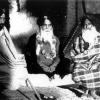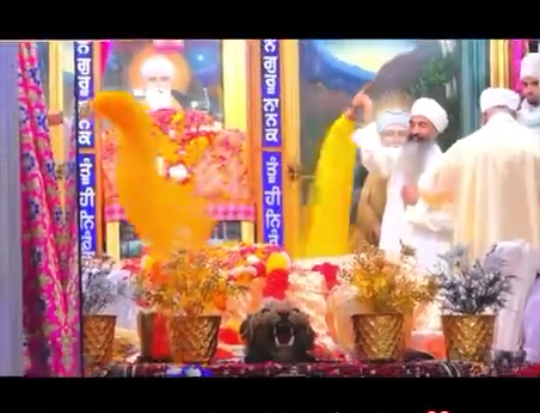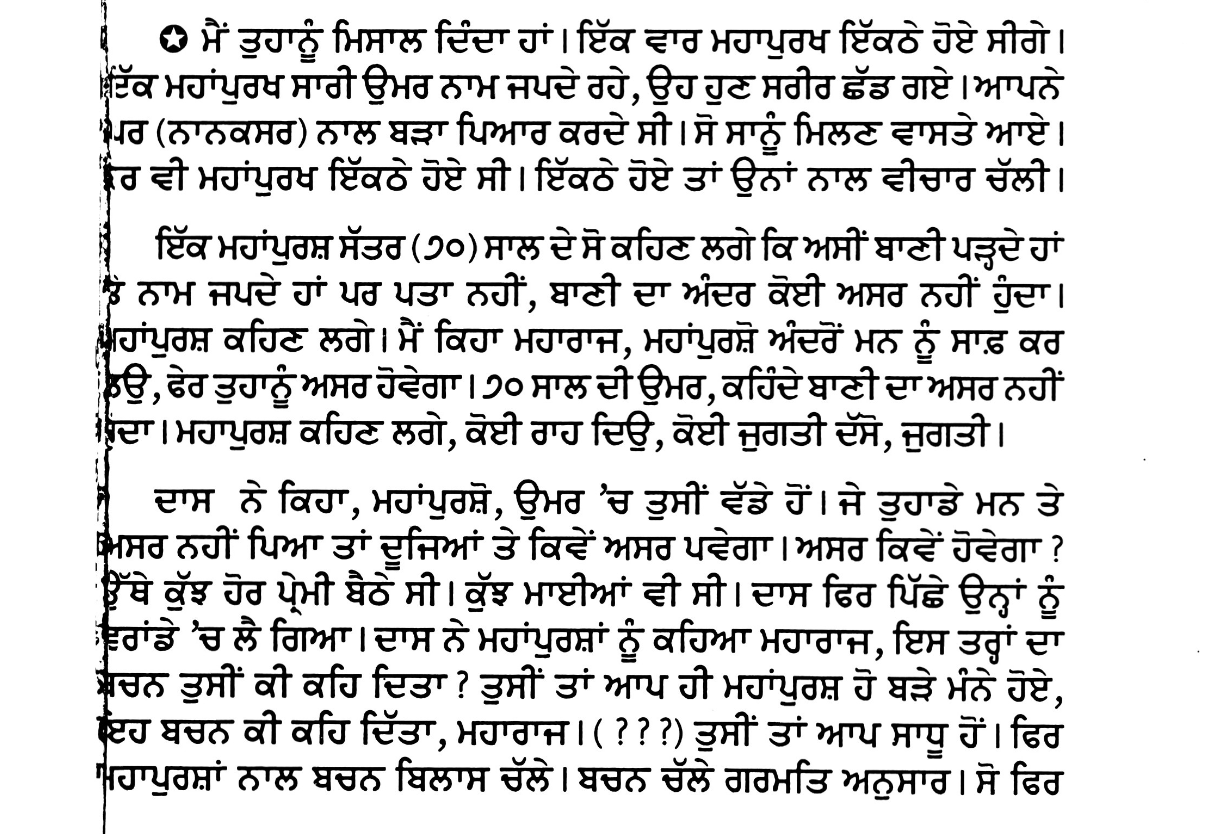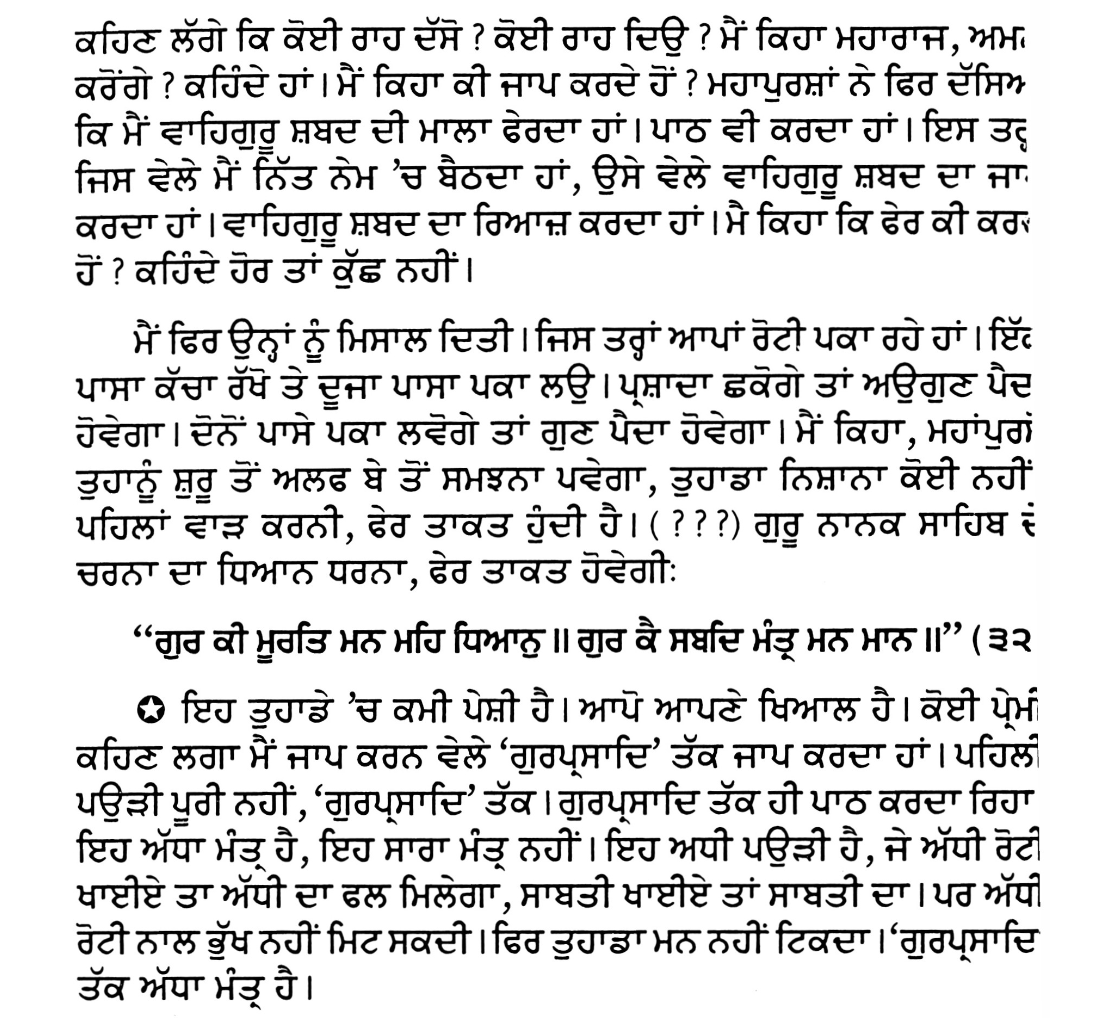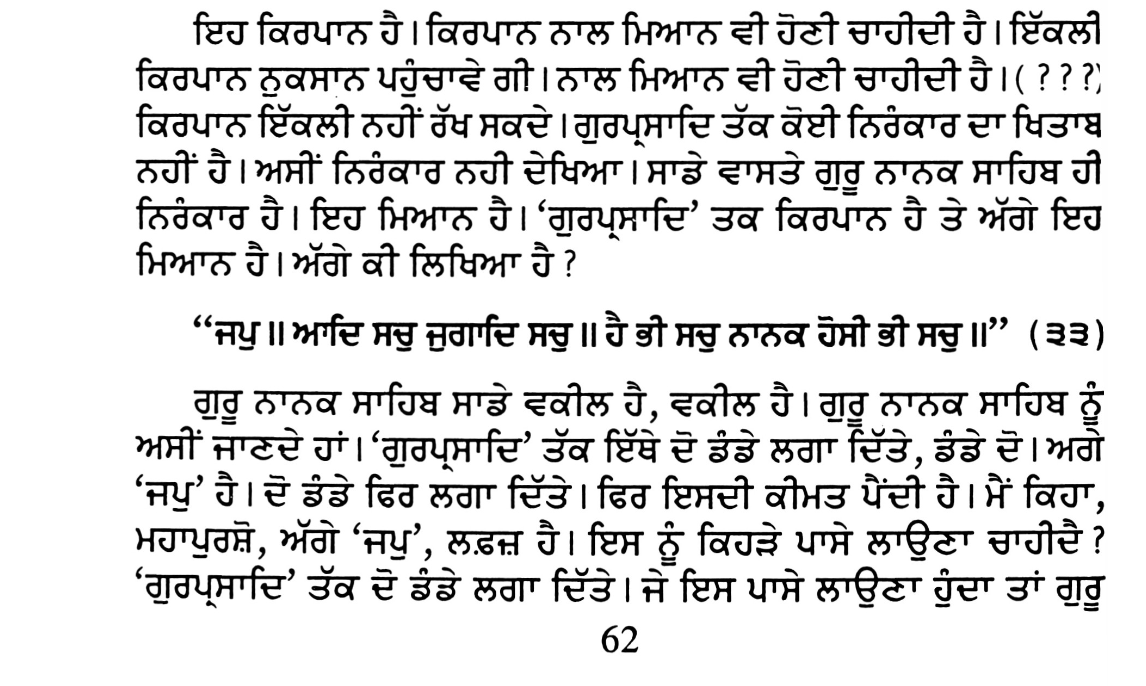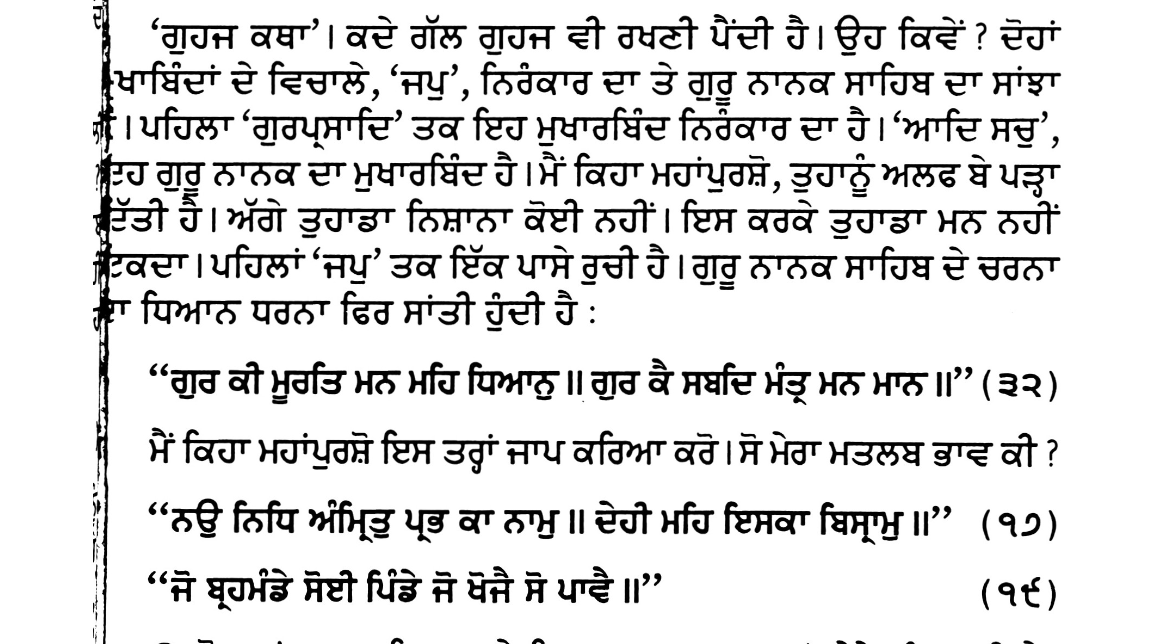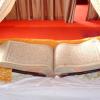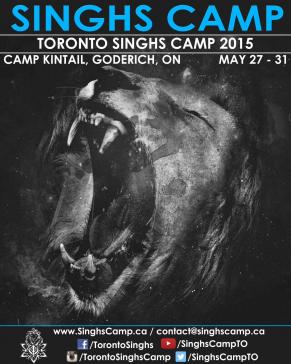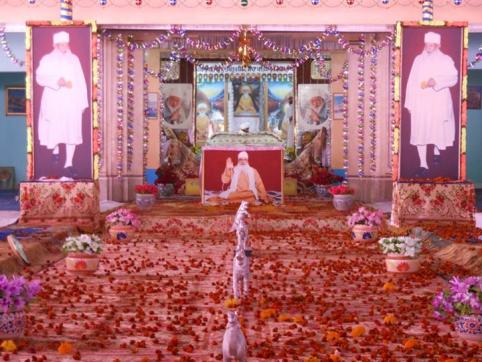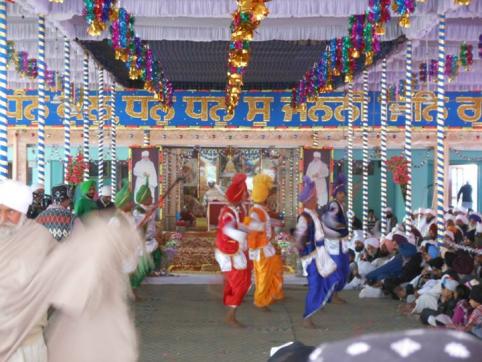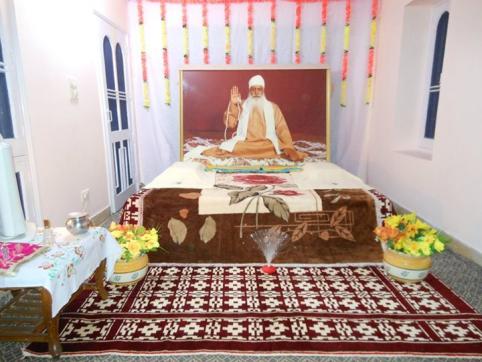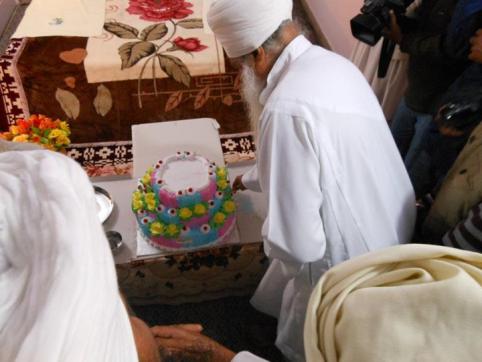Search the Community
Showing results for tags 'nanaksar'.
-
A bihari boy was suffering from a skin disease. He and his mother used to go to a gursikh doctor for treatment. The doctor was attached to nanaksar samparda and used to take no fees from poor patients. He tried to cure the boy but his medicines were not working. Finally he told the boy to go to a nearby nanaksar gurdwara Sahib and eat the langar there regularly. The langar at this gurdwara Sahib was prepared by Sabat Surat Sikhs reciting gurbani. In a short time the boy was cured of the skin disease.
-
According to Akal Takht maryada, only gurbani can be sung in presence of Guru Granth Sahib. What's wrong with these nanaksar vale? They are portraying as if nand Singh was a Guru.
-
Need ARDAS done in NANAKSAR GURUDWARE SAHIB or in SANT SUJAN SINGH JI GURUDWARE SAHIB Hindi or English both language will be easy to read ????
-
- ardas bani
- nanaksar
-
(and 2 more)
Tagged with:
-
(Request, please leave in general section) SikhVibes.com A Sikh Multimedia Website with thousands of rare Audio recordings, Videos and Katha from Worldwide. We have recently redesigned our layout with links to the following: Gallery section - connected to our Instagram account. Videos section - connected to Youtube! Events section - updated of local Toronto area programs. Visit our website daily for updates! www.SikhVibes.com FACEBOOK || INSTAGRAM || YOUTUBE || TWITTER
- 19 replies
-
7
-
- guru
- sikhi
-
(and 27 more)
Tagged with:
- guru
- sikhi
- kaur
- singh
- simran
- gurbani
- katha
- kirtan
- mp3
- keertan
- akj
- akhand keertan
- doola ji
- jagpal singh
- anantvir singh
- darbar sahib
- sikhvibes
- sdo
- bhai manpreet singh kanpur
- bhai jagpal singh
- bhai randhir singh
- taksal
- nanaksar
- nihung
- giani amolak singh
- sant jarnail singh bhindranwale
- talwara
- amritsar
- punjab
-
ਵਾਹਿਗੁਰੂਜੀਕਾਖਾਲਸਾ॥ ਵਾਹਿਗੁਰੂਜੀਕੀਫਤਿਹ॥ I love nanaksar I have question Why nanaksar not use small hair chore it was question im my mind since 2016 when i was 16 year old????????? i do not get answer till now if you know plz tell me
- 1 reply
-
- nanaksar
- nanaksar trust
-
(and 1 more)
Tagged with:
-
I have heard of a sant called baba nahar singh who was apparently the grandson of baba nand singh, but i didn't know that baba nand singh had children and grandchildren? can someone confirm or explain this?
-
- baba nand singh
- nanaksar
-
(and 1 more)
Tagged with:
-
Baba Harbhajan Singh Ji Nanaksar left this world for Sachkhand on 8 June 2018. Baba Ji was the successor of Baba Bhajan Singh.
-
can some one tell me why ragiis of nanaksar are celibate. also why they have diffrent maryada.
-
I have heard the term Nanaksar and GNNSJ used interchangeably. I was wondering whether they represent the same group, view points and Sants. In addition, what has been the opinion of Nanaksar Sikhs regarding the Khalistan movement and the problems in Punjab in the 80s? Do they support the cause of people like Bhai Surat Singh?
-

History Of The Case Against Sant Baba Amar Singh
Badal posted a topic in GURBANI | SAKHIAN | HISTORY
History of the Case against Sant Baba Amar Singh 2002 Citation: Gill et al v. Amar Singh et al Date: 20020628 2002 BCSC 969 Docket: C975444 Registry: Vancouver IN THE SUPREME COURT OF BRITISH COLUMBIA BETWEEN: WAHIGUROO PALL SINGH GILL, HARBANS KAUR GILL, TAGE KAUR SIDHU, AN INFANT BY HER GUARDIAN AD LITEM, JASMOHANJIT KAUR GILL, JASMOHANJIT KAUR GILL, ADMINISTRATRIX OF THE ESTATE OF SURINDER KAUR SIDHU, DECEASED PLAINTIFFS AND: NANAKSAR THATH ISHAR DARBAR AND AMAR SINGH SIDHU ALSO KNOWN AS AMARSINGH SIDHI ALSO KNOWN AS AMAR SINGH ALSO KNOWN AS AMARSINGH ALSO KNOWN AS BABBA AMAR SINGH JI DEFENDANTS REASONS FOR JUDGMENT OF THE HONOURABLE MR. JUSTICE FRASER Counsel for the Plaintiffs David H. Unterman Counsel for the Defendants Adam J. Roberts [1] This is a case which arises from and is to be decided upon the history of a 24-year relationship between Surinder Kaur Sidhu, a British Columbia businesswoman, and Amar Singh, a man regarded by her and by many other Sikhs around the world as a "Sant", that is, someone specially gifted to intercede with God on behalf of the faithful. [2] Two and one-half months before her death from breast cancer in 1997, Surinder Kaur Sidhu gave land owned by her, worth more than $1,000,000.00, to Amar Singh. It amounted to the whole of her estate. [3] Her mother, Harbans Kaur Gill, and her brother, Wahiguroo Pall Singh Gill, as guardians of her daughter and sole heir at law, Tage Kaur Sidhu, and Jasmohanjit Kaur Gill, as Administratrix of her estate, seek to set aside this transfer on the grounds of fraud and undue influence. In particular, they allege that, at a time when Surinder Kaur Sidhu was in an advanced stage of terminal breast cancer, Amar Singh promised her that, if she gave him the land, her cancer would be cured and that a temple would be built on the land in her honour. Surinder Kaur Sidhu died and Amar Singh put the land up for sale instead of initiating a temple project on the land. This action resulted. [4] The defence says that Amar Singh did not commit fraud or exercise undue influence, made neither of the promises alleged and was entitled to make whatever use of the land he saw fit. The defence also alleges that the land was held in trust by Surinder Kaur Sidhu for Amar Singh between the mid 1970's and 1997, the date of the transfer. References to Parties and Witnesses [5] I have decided that clarity will be helped if I refer in these Reasons to the extended family of Surinder Kaur Sidhu by their first names, as they referred to each other in their testimony. I will refer to her as "Surinder". The plaintiff Wahiguroo Pall Singh Gill I will refer to as "Pall". The plaintiff Harbans Kaur Gill I will refer to as "Harbans". The plaintiff Tage Kaur Sidhu I will refer to as "Tage". The plaintiff Jasmohanjit Kaur Gill I will refer to as "Jasmohanjit". I will sometimes refer to Piara Singh Sidhu as "Piara". Pall and Jasmohanjit are husband and wife, having married in 1986. [6] The defendant Nanaksar Thath Ishar Darbar is an Ontario society incorporated to own a temple in Mississauga. Institutions around the world associated with Amar Singh share this name. For example, there was a British Columbia society at a material time in the narrative called The Nanaksar Isher Darbar Gursikh Society. [7] The evidence is and I find that various institutions around the world, including the defendant society, are controlled by Amar Singh, notwithstanding that he may from time to time defer to the wishes of others involved in their administration. For simplicity's sake, I will refer in these Reasons only to Amar Singh, because the Ontario society is simply his alter ego. This, for example, explains my statement in paragraph 2 of these Reasons that Surinder gave the land to Amar Singh: in formal terms, the land was given to the Ontario society. Amar Singh testified that he did not own any property at all. The Sikh Faith and the References to it in this Judgment [8] The context of this judgment is the Sikh faith. [9] It would be wrong for me to pretend to have any command of the precepts of Sikhism. I did hear evidence of the history of Sikhism and of some of its tenets; any reference I make to them must be understood for the modest and explanatory purpose it has. [10] I will refer to Sikhism and some of its implications for this case. These references are, so far as the parties are concerned, entirely unnecessary. But there is a reason for me to do so: if my judgment in this case is appealed, the Court of Appeal may want to know whether I have misinterpreted the evidence about Sikhism which was put before me. I hope the parties will take charitably my attempts to describe their beliefs; and the fact that some things obvious to them have to be set out in the judgment in the first place. [11] Common throughout Sikhism is the tradition that there have been ten gurus, beginning with Guru Nanak (1469-1539). The tenth Guru was Gobind Singh (1666-1708). [12] A Sikh temple is a place for the singing of prayers and other ceremonies. All Sikhs use the Guru Granth Sahib as their governing holy text. Reincarnation is a very important part of their belief system; one of its aspects is that one's happiness and the esteem of others for you in future lives may flow from especially worthy behaviour in one's present life. This belief explains, I assume, why a Sikh will refer to a person "leaving his body", instead of "dying". [13] There is, as well, the concept of "Sant" in Sikhism. The word "Sant", as I understand the evidence, shares an origin in Sanskrit with the word "Saint". A Sant has special powers of intercession with God, which means that divine relief can be obtained by a Sikh with the help of a Sant. [14] A Sikh who regards another Sikh as a great teacher may attach the honorific "Baba Ji" to the name of the person he admires. The usage has some elasticity and sometimes merges into the concept of "Sant". The followers of Amar Singh typically refer to him as Baba Amar Singh Ji or Sant Baba Amar Singh Ji. Nanaksar [15] Nanaksar, a Sikh temple near Jagroan, in the District of Ludhiana, in India, is the place of origin of a branch of Sikhism founded by Nand Singh, who died in 1943. The work of Nand Singh was carried on by his successor, Isher Singh, who built the temple there. Isher Singh died in 1963. The followers of Nand Singh and Isher Singh regard this branch of Sikhism as more peaceful than mainstream Sikhism. "Nanaksar" in Punjabi means "the house of Nanak" or "the place of Nanak". The name refers to Guru Nanak. [16] The tradition of Nanaksar continues and its adherents regard Nand Singh and Isher Singh as the 11th and 12th Gurus. They are habitually referred to as "Sant Baba Nand Singh Ji" and "Sant Baba Isher Singh Ji" or variants of that form. [17] The existence of Nanaksar reflects an interesting reality of Sikhism: that, despite its long history, there has never emerged a universally recognized hierarchy. This means that individual temples are not established or authorized by a supreme authority; typically, a group of the faithful will identify someone as a spiritual leader and set out to build a temple at which they can receive spiritual guidance from this person. [18] Similarly, no governing authority exists which confers the status of "Sant". If a devout Sikh comes to believe that another person is a Sant, he may address him as such. [19] The premise on which Amar Singh carries on his work is that he is the successor to Nand Singh and Isher Singh, in the Nanaksar tradition. Credibility and Admissibility [20] The narrative which follows, entitled "The Long History", is extended. The reliability of the evidence varied, of course, and some of the recitation in the narrative may not be accurate. For example, I have set out Amar Singh's account of his early years, notwithstanding that I have found him not to be a credible witness. I did so because his testimony as to his early years does not affect the outcome of the case. When I say that a witness testified as to something, this indicates that I do not necessarily accept the testimony as accurate. Otherwise, the narrative is to be taken as embodying my findings of fact. [21] The right place to begin with respect to credibility is with the testimony of Amar Singh. He testified that he did not have many specific memories of conversations with Surinder at the material times. This, in normal circumstances involving one of his followers, could have been perfectly understandable. Amar Singh is the head of an international, spiritual empire, with I assume thousands of adherents. A conversation with any one of them is not something he could be expected to recall. [22] However, as to Surinder, there were special reasons for Amar Singh to remember his association with her vividly. These have to do with the history of their relationship and incidents which occurred during the relationship, including the notorious automobile trip from Seattle to Vancouver, the choice of Amar Singh to marry Surinder to his first cousin, his visits to Surinder in British Columbia shortly before her death and his visit to the funeral home after her death. I reject the testimony of Amar Singh that he has no helpful memory of his conversations with Surinder in the last year of her life. [23] Additionally, the Answers to the Interrogatories delivered by the plaintiffs to the Ontario society, sworn to by Sukh-jinder Singh Grewal, which were carefully based by Mr. Grewal on what he was told personally by Amar Singh, contradict the evidence of Amar Singh at trial. Mr. Grewal, a solicitor practising in Surrey, British Columbia, testified persuasively that his answers to the Interrogatories were confirmed directly and in advance by Amar Singh. [24] Mr. Grewal acted for Amar Singh when the land was transferred. No one suggests that he took any improper step during the transaction. He did not agree with the suggestion that he was a faithful follower of Amar Singh, but he has known Amar Singh for many years, attended upon Amar Singh during his visits to British Columbia and Amar Singh has stayed in his home from time to time. [25] My rejection of the evidence of Amar Singh is reinforced by my acceptance of the evidence of Tage, which conflicts with his. I find that Tage's evidence is truthful and accurate. Tage impressed me as a young woman of good character ¾ exemplified nowhere better, perhaps, than in her willingness while a teenager to forego her inheritance if it would save her mother ¾ and her testimony had the detail and spontaneity which are the hallmarks of truth. It was apparent that Tage was striving to be accurate in her testimony; among other things, she was perfectly willing to accept suggestions in cross-examination if they seemed to her to be true. There was no sense of calculation, no sense of an agenda. [26] I also accept the evidence of Pall. Despite his dishonest acts in helping Surinder obtain welfare, there was enough credible detail in his testimony to lead me to this conclusion. It seems to me, as well, that his act in signing the conveyance documents knowing that there could be tax and other adverse consequences shows him as a man determined to uphold his moral obligations. [27] I also accept the evidence of Harbans, with one exception, having to do with Surinder's receipt of welfare. Harbans would have me believe that Surinder said to her that when things got better, she would repay to the Government the welfare income she had received. I find this difficult to accept. Harbans said she disapproved of Surinder's receipt of welfare income but nothing in the evidence suggests that Pall or Surinder had qualms about Surinder receiving welfare despite being the beneficial owner of a valuable parcel of land. [28] In the affidavits sworn by Jasmohanjit as Administratrix of the estate of Surinder, there is no reference to the land or to debts. This, in my view, creates problems as to her credibility. However, the evidence of Jasmohanjit was not important in my assessment of the evidence. [29] The plaintiffs called Dr. Donald Dawe. Dr. Dawe is Dabney Professor Emeritus of Systematic Theology at the Union Theological Seminary in Richmond, Virginia. Dr. Dawe has been interested in Sikhism for many years and has immersed himself in the study of it. Some of the historical evidence I refer to in this judgment comes from his testimony. [30] To the extent that the evidence of Dr. Dawe refers to Amar Singh specifically, however, I am unable to accept it. This was a maiden voyage for Dr. Dawe in the role of expert witness. I find that he was insufficiently aware of the need a court has for authenticity of documents and reliability of information. Among other things, Dr. Dawe had looked at internet sources of unknown provenance. The defence was concerned as to Dr. Dawe's neutrality, given that he has examined some of the records of a law suit against Amar Singh in California, also based on allegations of fraud. However, the particulars of that case were not put before me and I conclude that they do not affect the reliability of Dr. Dawe's testimony as to the history of Sikhism. [31] The evidence of the other witnesses, I accept, in the main. Their testimony provided context. The Long History: 1: The Gill Family [32] Surinder's paternal grandfather came to Canada from India in 1906. His son, Sardara Singh Gill, Surinder's father, has roots in Canada going back to 1925 and is a Canadian. Thus, Surinder and her siblings were automatically Canadian at birth, although they were all, except her younger brother Sukhdeep, born in India. Her mother, Harbans, however, was not a Canadian citizen. [33] Six children were born to Sardara Singh Gill and Harbans. Surinder was the oldest, born on 2nd February 1941. Two of the six died at less than 5 years of age. The remaining three, in order of their birth, were Harinderpal, born in 1949, Pall, born on 14th July 1956, and Sukhdeep, born on 24th October 1965. [34] In India, the family lived in a village not far from Nanaksar. Harbans and her sister adhered to this temple and Harbans took Surinder and Harinderpal there a number of times, sometimes staying there to do voluntary service. This was in the time of Isher Singh. [35] Surinder was 15 when Pall was born. Pall did not thrive; his parents and Surinder feared that he would die in infancy. Harbans had recurring, threatening dreams about Pall. Pall's older brother, Kuku, had died in childhood. They took the baby to Isher Singh; he assured the family that Pall would henceforth be healthy and that Harbans' dreams would stop. The dreams did stop and, ever since, Pall has been healthy. Isher Singh also gave Pall his name, "Wahiguroo Pall", which has a godly connotation. [36] This was an important event in the strong faith which Surinder had in the last years of her life. She accepted as a truth that it was the intercession of Isher Singh which transformed Pall from a sickly baby to someone who never afterwards in her lifetime had any significant health problem. [37] In 1963 Surinder's father (Sardara), Surinder, Harinderpal and Pall came to Canada. They were entitled to do so, as Canadian citizens. Harbans had to stay behind in India, because she was not. [38] Tragedy hit the family soon after their arrival in Canada. Harinderpal, perhaps already seriously ill when she arrived, sickened and died. She was 14 years old. Her death hit the family hard: she had been an effervescent, sprightly and much-loved child and sister. They had given her the affectionate nickname "Pali". [39] The family had received advice from Isher Singh about Pali's condition. His advice had been, "See a doctor but do not have surgery". But, in Vancouver, she was admitted to hospital and subjected to exploratory surgery, during which she died. [40] Surinder, remembering the advice of Isher Singh, believed that Pali's death was caused by the surgery. I find that Pali's death reinforced Surinder's belief that the intercession of a teacher and Sant like Isher Singh was more determinative of life and death situations than any medical treatment could be. [41] Harbans joined the family in Vancouver in 1963, after immigration procedures had been successfully completed. She did not know until she arrived that Pali had died, the family having decided to protect her from the news. [42] The family settled in Vancouver. Surinder became a licensed real estate agent. According to Pall, she loved Canada and embraced what she felt was the greater personal independence she had in this country, compared to India. [43] Perhaps it was this sense of independence which led her in 1967 to marry, against her parents' wishes, a man not of the Sikh faith, Sandarshi Sharma. (Mr. Sharma was a Hindu.) [44] The family accepted him, however, and from time to time Surinder and her husband lived in one or other of the homes that the family had bought. [45] The Gill family remained a cohesive one, a fact that meant that the formal title to the homes they bought did not necessarily reflect the reality that these homes were treated as if they were family property. Members of the family moved in and out of the homes ¾ Pall moved out when he married, for example ¾ but, throughout, there was, I find, a shared understanding in the family that each of them could expect shelter in a home owned by any other. [46] Surinder also, however, was investing in land, buying and selling properties. These she registered in her own name. [47] In March, 1973, she bought a five-acre parcel of land in Surrey, B.C., at 10613 - 168th Street, for $66,000. It had a large and a small house on it, which were rented out. [48] It was not long after that acquisition that Amar Singh first came to Vancouver. The Long History: 2: Amar Singh [49] Amar Singh was born on 1st November 1942, in Chakar, India. He testified that he was raised by an aunt after his parents died when he was eight months old. As a child, he learned how to read the Guru Granth Sahib (which is written not in Punjabi but a special language of its own) and he prayed. [50] He testified that at about age 13, he came to Nanaksar. This would have been about 1955. Isher Singh was still there. About 300 people lived at or near the temple. Amar Singh testified that Isher Singh sent him to various places to study hymn singing, the small drum and classical music. Amar Singh was back at Nanaksar for at least a year before Isher Singh "left his body" in 1963. [51] The singing of hymns is at the heart of Sikh religious observances. It is so central that a hymn-singer can become regarded as a worthy person around whom to found a temple. [52] Amar Singh is an inspiring hymn-singer. Travelling in India to sing, at the invitation of others, he became well known. [53] There are now 33 schools and temples in which he is the central figure, in many parts of the world: Singapore, the United Kingdom, the United States, Ontario, and, of course, India. Some, or many, of his followers regard him as the 13th Guru, after Nand Singh and Isher Singh. [54] As early as 1969, some Sikhs began to call him "Sant." He does not assert himself that he is a Sant but allows others to do so. In cross-examination, he said, "I don't want that [i.e. being called a Sant]. But the people who call me because of their belief, we cannot call them incorrect."[1] He also allows himself to be referred to in literature sent out from his United Kingdom establishments as "Sant Baba Amar Singh Ji". He conceded that Nand Singh and Isher Singh would not have permitted themselves to be addressed as or referred to as a Sant. [55] He came to Vancouver in 1973 because he was invited to sing at the Ross Street Temple. He spent 40 days there. By then, he was routinely treated with the extreme deference and respect due to an important spiritual leader and teacher. White cloth would be placed on any chair he was to sit in; all others would sit on the floor in his presence. Food was served to him first and what he did not eat was afterwards passed around to the faithful as blessed food. He travelled with a retinue of young musicians, singers and servants, dressed in white, like himself. He refers to himself as "we" or "us" (depending on the grammatical context), that is, in the plural form. [56] This was when Surinder and Amar Singh met. Her marriage was in trouble and her mother, Harbans, took Surinder to Amar Singh for advice. Amar Singh encouraged Surinder to leave the marriage and told her he could find a husband for her whom she could marry according to Sikh principles, before the Guru Granth Sahib. [57] Amar Singh deeply impressed a number of those who saw him and heard him at the Ross Street Temple, so much so that in 1974 they formed a group to build a new temple at which he would be the guiding influence. They raised money among themselves to buy land. [58] Surinder supported the project wholeheartedly. She offered to sell the 168th Street property to the group, at slightly above her cost, as the site for the new temple. Amar Singh approved the location, the group decided to buy it and did, in July 1974. The B.C. society was incorporated the same month and became the registered owner of the land in August 1974. [59] In the months that followed, prayer meetings and religious ceremonies were held at the property, in the bigger of the two houses on it. Amar Singh was present for at least some of them. [60] There then occurred what to the faithful group was an irredeemably unacceptable event. Amar Singh had been visiting followers in Yuba City, California; he decided that, after his time there, he would come to British Columbia to visit the fledgling 168th Street congregation. Through a subordinate in California, Amar Singh sent a message to Surinder that he needed to be driven from Seattle, where his flight from California ended, to 168th Street. Surinder decided that she would drive to Seattle and drive Amar Singh back from Seattle to Surrey. She left for Seattle, by herself, on a day in late December 1974 and returned the next day with Amar Singh. [61] When word of this reached the supporters of the temple project, the project collapsed. To understand cause and effect, one must understand that for believing Sikhs of the Nanaksar tradition, faith and duty permeate their existence. The devout embrace their faith with a passion freely given and of such dimensions that doubt or equivocation forms no part of the picture. Attention to the Guru Granth Sahib, attendance and participation in prayers at the temple, respect and deference to one's parents, loyalty to family and observance of a code of moral purity are all aspects of the life of a devout Nanaksar Sikh. Two stories from this trial exemplify this: 1. The witness Gurmail Singh Kainth told me of the respect and honour he accorded to his wife's father, leaving no doubt in my mind that it was given willingly, cheerfully and as of course. He radiated joy and energy while describing the obligations his faith required of him, including the rejection of impure thoughts. 2. Pall and Jasmohanjit spent their honeymoon reading aloud to each other from the Guru Granth Sahib. [62] All we know is that Surinder drove down to Seattle one day and returned the next, with Amar Singh. No matter. For the supporters of the temple project, what they knew ¾ Surinder had made the trip, stayed overnight, and returned in her car alone with Amar Singh ¾ was enough. This was not what a revered teacher, guru or Sant would allow to happen. Such a person is to exemplify moral purity, including celibacy. [63] This is nowhere better illustrated than in the testimony of Mr. Kainth: he was too repulsed by what he thought may have happened in Seattle to speak the words which would describe it; he would have felt unclean in doing so. (He did not use these words but conveyed this unmistakably.) This kind of stance in a witness can sometimes spring from disingenuous motives; I did not doubt the sincerity of Mr. Kainth. [64] The episode destroyed the supporters' faith in Amar Singh and they abandoned the 168th Street temple project. [65] The group re-conveyed the land to Surinder in February 1975 on payment by her of the price they had paid her for it, plus compensation for certain expenditures which had been made. They allowed the society they had formed to lapse. Title to the land was back in her name. [66] In the evidence is a note in Surinder's handwriting, "owner is S.K. Sharma in trust". It is reasonable to place this undated writing some time in the late 1970s, probably 1976. (She at that time was still S.K. Sharma.) The Long History: 3: The Years Between [67] Although the temple project had fallen through, and although Amar Singh was regarded as unworthy by most of those in the 168th Street project who had valued him before, Surinder and some others in British Columbia remained loyal to him. [68] Some years after the collapse of the temple project, Amar Singh began to make quiet, unobtrusive trips to the Lower Mainland, during which gatherings were held at homes of the faithful. He would receive followers at the home where he was staying, where he was accorded the deferential treatment I have already described. Some of these occurred at the home of Sukh-jinder Grewal. [69] In the latter half of the 1970s, Surinder travelled to India a number of times to visit Amar Singh. [70] On 13th July 1978, Surinder obtained a decree absolute of divorce from Sandarshi Sharma. They had separated after Amar Singh had advised her to do so. [71] In October 1978, Surinder transferred the land to her mother, Harbans. In July 1979, the land was transferred back from Harbans to Surinder. In September 1979, the land was transferred from Surinder to her parents, Sardara and Harbans. There was a pattern of Surinder transferring the land out of her name before she went on a trip to India. [72] In June 1980 Surinder travelled to India to meet again with Amar Singh. The purpose of the journey is not entirely plain, but one available inference is that Surinder was relying upon Amar Singh to provide her with a husband. [73] Piara Singh Sidhu was Amar Singh's first cousin, being the son of the aunt who had raised Amar Singh as a child. Piara was 13 years younger than Amar Singh, which meant that he was 13 years younger than Surinder. He was short, one of his feet was mildly deformed, one leg was shorter than the other and he walked with a limp. This was not of concern to Surinder, because of her belief that Amar Singh could cure these deformities and make Piara taller. [74] It seems likely, although I could not find this as a fact, that it was Piara whom Amar Singh had in mind as a future husband when he advised Surinder in 1973 to abandon her marriage to Mr. Sharma. Piara visited British Columbia in the late 1970s, and he and Surinder were either introduced or knew of each other's existence. [75] The evidence is very cloudy whether there was, in India, a ceremony of marriage between Surinder and Piara. To her family, Surinder appeared embarrassed at the absence of any documentation evidencing a marriage. She began to call herself Surinder Kaur Sidhu. [76] Surinder and Piara travelled from India to England together in 1980 but Piara refused to accompany her from there when she returned to British Columbia. [77] Not long after her return to British Columbia in the autumn of 1980, Surinder learned that she was pregnant. Her daughter, Tage, was born in Vancouver on 22nd June 1981. Surinder in the birth registration described herself as "married". [78] Tage has never met Piara. [79] Over the years between 1975 and 1996, Surinder and Pall discussed development of the 168th Street property. They tried to sell it in 1986 and 1987. In various documents, Pall is described as the owner. Meantime, Surinder, although not on title, was dealing directly with municipal authorities about rezoning, and the like. [80] Over the years, all members of the family helped out in the management of the property: cleaning the homes, collecting rent from tenants, and so on. [81] For the last several years before the transfer to Amar Singh, title to the land was in the name of Pall and Harbans. [82] In 1988, there were marital difficulties between Pall and Jasmohanjit. She commenced proceedings under the family law regime alleging that the 168th Street property and other properties registered to various members of the Gill family were family assets, that is, assets in which she had an interest. The proceeding was eventually abandoned and Jasmohanjit and Pall reconciled. But it generated an affidavit from Surinder sworn on 16th December 1988, in which she asserted that the reason she had put title to the 168th Street property in the names of various family members over the years included that, [A]s a woman in the Sikh community, I felt it best not to appear to be wealthy as I am, having an estate of a value in the area of $1,000,000.00 and I regret that I am by these proceedings now obliged to make public the extent of the same in this affidavit. This was explained to me as meaning that Surinder had a fear of being exploited or abused, especially when she was in India. [83] Surinder fell on hard times toward the end of the 1980s. Beginning in January 1991, she began to receive welfare. In periodically filling out the forms required, she did not list the 168th Street property as one of her assets. She also claimed to be paying rent in various amounts, which was untrue. The assertions about rent were supported by documents signed by Pall, as her "landlord". Surinder continued to receive welfare income until her death in 1997. [84] In October 1995, Harbans and Pall, who were registered on the title as owners of the 168th Street property, applied for and received a mortgage over it from the Canadian Imperial Bank of Commerce. The face value of the mortgage was $1 million, reflecting an intention to develop it. Of that, approximately $135,000 actually was advanced. This money was used to pay family debts incurred by Pall in real estate developments and for overdue property taxes. [85] The bank did not know of the existence of Surinder. Harbans and Pall obviously made no mention of her and there was nothing in the documents which would have alerted the bank to any suggestion that Surinder had a beneficial interest in the land. I think it plain that Surinder knew of the mortgage application and agreed with it. The Long History: 4: Surinder's Cancer [86] At some time in 1994 or 1995, Surinder discovered that she had lumps in her breasts. She at first dealt with the situation by altering her diet. By September 1995, however, one breast had enlarged and the other had become very hard. Her energy was diminishing. [87] In February 1996, Surinder went to see Dr. J.S. Rai, her family doctor. The clinical record discloses a finding of "a large carcinoma". Surinder was immediately referred to Dr. K.F. Lai, a specialist. Dr. Lai found on the same day that there were very large tumours. [88] Surinder refused a diagnostic fine needle biopsy, despite what Dr. Lai described as "the possible diagnosis of malignancy in both breasts." [89] On 14th February 1996, Dr. Rai told Surinder that she did have breast cancer. The entry in her clinical notes for 26th March 1996 reads: Patient has adamantly decided not to seek any treatment for breast cancer. [90] Tage was 14 when the diagnosis was made. She spent much of the following year caring for her mother. [91] Surinder did not see a doctor again until September, 1996, when she saw Dr. Karen A. Gelmon, a medical oncologist employed by the B.C. Cancer Agency. By then, there were open wounds on her breasts. Dr. Gelmon's report gives the grim situation in brief compass. Surinder had, by September: a 12 X 10 cm, oozing, necrotic, and odorous mass on the right breast. The left breast had a similar 8 cm mass. Both had necrotic ulcers within the masses. ... She therefore presented with clear cut evidence of locally advanced bilateral breast cancer and a suspicion on clinical examination of metastastic disease to her liver. The suspicion of metastastic disease was confirmed by ultrasound. The diagnosis was that she had "advanced, metastastic breast cancer that was not curable." Surinder underwent chemotherapy, intended to "prolong good quality life for as long as possible." There was brief, modest improvement. [92] By 28th October, however, there was pus in her right breast and it was draining blood-tinged fluid. Her breasts were being dressed at home twice a week, by a visiting nurse. [93] Surinder did not keep her chemotherapy appointment for 14th November but came in on 5th December. She told the doctors that she did not want further chemotherapy. Her right breast was almost totally replaced by tumour and there was a marked weakness of the right arm. The doctors felt that "urgent radiation was indicated". A short time later, Surinder declined radiation. Dr. Gelmon prescribed morphine for her pain. [94] On 14th December 1996, Surinder took an overdose of the morphine and was admitted to Surrey Memorial Hospital. She was dealt with as someone who had attempted suicide. She knew by then that, in the opinion of the medical doctors who had seen her, her situation was hopeless. Late in December and again in January, Surinder agreed to and underwent radiation. This was undertaken only for the purpose of comfort. Some of her skin went black as a result of the radiation. She refused excisional biopsies. [95] Surinder's long, handsome hair fell out. [96] The burden of care for Surinder at this time was being carried by Harbans and Tage. Surinder had, early in December 1996, discharged the nurses who were visiting her at home to change her dressings and attend to her other needs. Tage, in particular, was her mother's constant companion, even sleeping in the same room. To Tage and Harbans fell the task of cleaning Surinder's breasts everyday, wiping up the discharges of pus and blood and applying new dressings. [97] By February 1997, Surinder was in a wheel chair. She had to be lifted to the toilet and helped into the tub. Tage would bathe her. She had memory problems. The Long History: 5: Surinder's Communications with Amar Singh during her final illness [98] From the time of her diagnosis in February 1996 until her death, Surinder was talking to Amar Singh by telephone. As her condition deteriorated, these communications became more frequent, and more urgent. [99] There is an evidentiary issue about these telephone calls. The plaintiffs assert that Amar Singh made certain representations to Surinder in these conversations. The only evidence we have as to what was said in some of them by Amar Singh is the testimony of Tage, based on what her mother told her. This evidence I find inadmissible as to whether Amar Singh had said what Surinder told Tage he had said. The necessity requirement for permitting the admission of hearsay evidence is of course met but the reliability requirement is not. By all accounts, Surinder was not coping with the reality of her situation. However, what Surinder said to Tage about what Amar Singh had said to her is admissible as evidence of her state of mind, a central consideration in this case. [100] Of course, the statements of Amar Singh which Tage or Pall heard directly or which Amar Singh has admitted are admissible. Apart from the hearsay evidence in which witnesses told me what Surinder had told them as to what Amar Singh told her, there is ample, direct evidence as to what Amar Singh told Pall and Tage, intended for Surinder's ears. [101] Amar Singh testified that he told Surinder "many times" that she should read the scriptures and "we will pray for her and she will get better".[2] In this statement, "we" is Amar Singh's reference to himself. [102] In March 1996, Surinder's brother Sukhdeep, a schizophrenic, had a psychotic episode which required him to be hospitalized. [103] Tage testified that the theme of her mother's conversations with Amar Singh was constant. Surinder would ask Amar Singh when she was going to be cured; Amar Singh would reply "soon" or "fast". [104] Surinder also persuaded Tage to telephone Amar Singh herself, thinking that Amar Singh would pay attention to the request of an innocent child and do what she asked. Tage had a number of conversations with Amar Singh, in which she asked when her mother was going to get better. The answer of Amar Singh consistently was, "Fast. Don't worry, she will get better". This happened a number of times between February 1996 and May 1997. [105] The evidence is also suggestive that Surinder was encouraged by Amar Singh to reject the validity of "western" medicine. Surinder believed that Amar Singh had declared that "there was no such thing as cancer". I am unable to go so far as to find either as a fact but it may be observed that what Surinder did is consistent with her having received such advice, in particular, the fact that she had no contact with doctors in British Columbia between March and September 1996. [106] What is unmistakable is that Surinder, once the diagnosis of cancer had been made, pinned all her hopes on Amar Singh. What medical attention she did receive in 1996 and 1997 amounts only to brief lapses. [107] The testimony of Tage was eloquent and completely persuasive about this. Tage was with her mother when her mother fretted and dithered about the questions she should ask Amar Singh and the requests she should make to him. Surinder sometimes would rehearse these conversations in advance, writing notes in Punjabi as to what she ought to say. [108] For example, a note which appears to have been made in November 1996 reads: Would I recover at home? // You are the doctor, you are the master of everything. In India, you said after you arrive, you will certainly do something. At the bottom, there is that piece, and at the top the skin is all rotten. There are kinds of holes, too. It becomes stiff and then there is pain. When will the breast start looking normal? [109] A later note, from 14th November, reads: Baba Ji, I don't know what mistake I am making now. // You say every day that you can make me better immediately. Baba Ji, I even obeyed your hukam [order] regarding the water. // Immediately means today as soon as I hang up the phone. // Baba Ji you, you personally said that I have suffered a lot. Please - please Baba Ji, please Baba Ji // The whole condition is not better than before - no // (England, Toronto) (I, Baba Ji knows) // Why is that? [110] A note from late November 1996 says: You tell me what I should do now so that the breast cancer would completely go away, so that I would completely recover. [111] At about this time, Amar Singh was asking Surinder for a donation of money for the benefit of the Ontario society, which operated the Nanaksar temple in Mississauga. He asked for $40,000. It was at about the time of Surinder's suicide attempt in December that the Gill family managed to raise $15,000 and donate it to the Ontario society. [112] As 1996 progressed, the conversations between Surinder and Amar Singh became more frequent: Tage recalls them as an everyday event. In the telephone bill submitted by the plaintiffs for the month of 27th October to 25th November 1996, there are 56 recorded long distance calls, as many as six in a single day, to various places around the world where Surinder thought Amar Singh might be. In the following month, 26th November to 25th December 1996, there were 124 long distance calls. On 5th December 1996 alone, there were 14 long distance calls. It is not that Surinder was successful in reaching Amar Singh in all of these calls; rather, the evidence is that she was desperate to reach him and tried repeatedly to do so. [113] The defendants were asked to produce their own telephone records but did not do so; Amar Singh testified that they had been destroyed. [114] It was toward the latter part of 1996 that Surinder began to associate her cancer and the other problems of her family ¾ Sukhdeep's schizophrenia, the family's financial reverses ¾ with her ownership of the land. This was described graphically by Tage: From then on, she just continues to be in more pain and she starts wondering: why is she having such a difficult life? Why does she having through this? Why the financial problems in the family are going on? Why her brother Steve [sukhdeep] is sick? Why all these bad things are happening to our family? And she asks Babba Ji this. She says: you know, I don't understand why are we going through so much pain. You know, my brother, he's very sick. You know, he has a mental illness. I've had car accidents before. I've been in so much pain. Now I have cancer and I'm in so much pain now. The problems between Pall and Jessie [Jasmohanjit], you know why, why is that happening to our family? And he says that all these problems are due to this property. The property was in Nanaksar's name at one time and now it isn't, and that's why your family has so many problems. [115] The last four lines of the above quotation reflect what Surinder told Tage and the passage is therefore inadmissible hearsay about what Amar Singh may have told Surinder. However, it is admissible as evidence of Surinder's belief. [116] Amar Singh came to Vancouver in January 1997 and visited Surinder twice, at her home. Surinder "had a very hard time" touching her head to the floor to bow to him, while he sat in a chair. After the first visit, Tage and Surinder ate the leftovers for the food which had been prepared for Amar Singh, because it was blessed food. Later the same day, Amar Singh came and met with Surinder alone. [117] After these two visits, the telephone calls increasingly originated with Amar Singh. The evidence of Tage is that Amar Singh would call and ask if a decision had been made regarding the land, and if Surinder had spoken to Pall and Harbans. According to Tage, Surinder continued to ask Amar Singh about her health and asked him why she was not better. This evidence suggests that the ordinary response of Amar Singh was, "Don't worry, you are going to get better. You are going to get better fast." Again, the content of these conversations, so far as Amar Singh is concerned, is hearsay from Surinder to Tage. That it was Amar Singh who was placing the telephone calls, however, is not hearsay. [118] In the notes made by or for Surinder, for the purposes of her conversations with Amar Singh, there is no reference to the land or to any promise to build a temple on the land. The Long History 6: Surinder's Decision to Give the Land to Amar Singh [119] In February 1997, Surinder was mortally ill. Her only asset was the land. She had a 15 year old daughter. If she gave the land away and died, her daughter would inherit nothing. Why, then, did she gift the land to Amar Singh? [120] The conversations Surinder had with Tage and with Pall answer this question. Surinder repeatedly asked them whether giving the land to Amar Singh was the right thing to do. She believed that if she did so, she would be cured. Tage and Pall both gave her the same answer: if it will cure you, of course you should give the land. Additionally, Pall and Tage were supportive of the idea of a temple being constructed on the land, in Surinder's honour. Prayers would have been said at the temple in her name or for her. Donating the land for a temple would be a deed which would serve her well in her future lives. [121] There is no direct evidence that Amar Singh made either of the promises to Surinder which are alleged by the plaintiffs: that if she gave the land, he would cure her cancer and that a temple in her honour would be built on the land. On the other hand, the evidence is irresistible that Surinder, Pall and Tage all believed that that was what had been offered to Surinder by Amar Singh. [122] Surinder told both Harbans and Pall that she was giving the land to Amar Singh in order to survive. In Pall's words, "Transferring the land was something we had to do. At that crucial moment, there was not any other hope. We had to do something. If that is what he [Amar Singh] wanted, then we should do it". Surinder had told Pall, "The only way I can get better is through Babaji. He is the only one who can make me better. We have to please him." [123] Surinder believed that Amar Singh had it within his power to intercede with God on her behalf, so that she would be cured of her cancer. Pall and Tage also believed that Surinder's life was in the hands of Amar Singh and that he could cure her. Amar Singh admitted that the Gill family called him "Sant" and "Babaji".[3] Their belief that he was a Sant is persuasive of the concomitant belief that he could see to it that Surinder's cancer was cured. [124] There was a particularly poignant moment in the trial, when Tage told me about Amar Singh's visit to the funeral home where Surinder's body had been laid out. Tage believed that Amar Singh would pull away the shroud and that her mother would get up from the bier, raised from the dead and healthy again. Apart from the transfer of the land itself, this seems to me the most powerful single piece of evidence of the faith Surinder, Pall and Tage placed in Amar Singh. [125] According to the testimony of Amar Singh, Surinder's decision to give the land to him was much simpler, and shorter. He testified that Surinder had called him and said, "I want to give this property to Nanaksar", to which he replied, "It's your belief, it's up to you." The Long History: 7: The transfer of the land [126] In February 1997, Surinder instructed Harbans and Pall, who were still on title to the land, to transfer the land to Amar Singh. Amar Singh had already telephoned Sukh-jinder Grewal and asked him to handle the transfer. [127] Mr. Grewal and Surinder had five or six conversations. She told him that she was anxious to have the transfer done as quickly as possible. Mr. Grewal testified that Surinder told him in these conversations, more than once, that she was holding the land "for" Nanaksar and wanted to transfer it "back". However, he made no notes to this effect at the time. [128] Harbans was dubious about the transaction and about Amar Singh. When she began to raise her doubts to Pall, he reminded her that the Guru Granth Sahib provides that it is impious to "slander" a Sant. Harbans was silenced by this rebuke. [129] Harbans and Pall came to Mr. Grewal's office in February 1997 to execute the conveyance documents which he had prepared on the instructions of Amar Singh. Very properly, Mr. Grewal told them that they should receive independent legal advice and gave them blank forms of Certificates of Independent Legal Advice. Mr. Grewal, I find, regarded himself as, if not the solicitor for Amar Singh, at least his agent, such that it would be inappropriate for him to witness the conveyance documents. [130] Harbans and Pall then went to see Ravinder Singh Binpal, a solicitor practising in Surrey. Mr. Binpal was shocked at the absence of documentation and surrounding preparation. He sent them away, suggesting that they get advice on the tax consequences of the transfer. This they did, from an accountant. They then returned for a second meeting with Mr. Binpal, at which he strongly advised them not to go through with the transaction. Mr. Binpal did sign the Certificate of Independent Legal Advice, but endorsed it with a notation that he had advised Harbans and Pall not to go through with the transaction. [131] Mr. Binpal's reasons were legal ones; he did understand, however, that the underlying purpose of the transfer was religious, although he has no specific recollection of Pall telling him, as Pall said he did, that a temple was to be built on the land. Harbans understood little of what was going on. She was there simply to do what Surinder wanted her to do. [132] Mr. Binpal never knew that Surinder was the real owner of the land. [133] On 20th February 1997, in the office of Mr. Binpal, Harbans and Pall executed the conveyance documents, transferring the land to the Ontario society. Pall delivered them to Mr. Grewal the same day. [134] Surinder died on 3rd May 1997, of her cancer. [135] The transfer was not registered until three days after her death. I accept the evidence of Mr. Grewal that the delay in registering the conveyance had to do with the condition placed on it by Surinder that the existing mortgage be paid off. Mr. Grewal testified that it was a struggle for the Ontario society to raise the necessary money, $132,800.00. [136] In the transfer, the consideration was stated as "$1.00 and Natural Love and Affection". The value of the property was stated at $1,375,000.00. The Long History: 8: The attempted sale of the land by Amar Singh [137] Amar Singh has an adviser in England, Peter Barnsley, who acts for "Him in matters relating to buildings and land transactions."[4] After Surinder's death, Mr. Barnsley was called in to advise Amar Singh as to the best use of the land Surinder had given. Mr. Barnsley came to British Columbia. He and Mr. Grewal both advised Amar Singh that the property was unsuitable either for a temple or Sikh school. Mr. Barnsley was not a witness at the trial and Mr. Grewal demonstrated no awareness of any promise by Amar Singh to build a temple on the land. [138] An agreement for sale was entered into between the Ontario society and Parmjeet Singh Barn and nominees for the price of $1,850,000. This agreement was signed by Amar Singh, personally. Through a series of assignments, Jatinder Minhas and Bhupinder Singh Nijjar acquired the status of purchasers under the agreement. [139] The Gill family learned of the pending sale in September 1997 and consulted Mr. Unterman, who filed a caveat against the property on behalf of Jasmohanjit, as Administratrix of the estate of Surinder. [140] Mr. Minhas and Mr. Nijjar commenced an action against the plaintiffs in this action, in which the allegation, essentially, is that the filing of the caveat frustrated the agreement for the sale of the land. This is proceeding C996849, in this court. Their counsel in the proceeding is A.G. Sandilands. They also commenced an action against the Ontario society, C982517, alleging breach of the agreement for sale. The Collateral Actions [141] At the request of the parties in this action and at the request of the plaintiffs Minhas and Nijjar in proceeding C996849, I seized myself of that proceeding. I was concerned, both at the case management stage and in the early stages of this trial that Mr. Minhas and Mr. Nijjar ought to be participating in it, given that the outcome of this trial might well bear on the merits of the caveat filed by Mr. Unterman. I was also concerned that, even if the plaintiffs in this action were successful, Mr. Sandilands' clients might have some sort of claim based on the fact that the conveyancing documents signed by Harbans and Pall allowed title to be registered in the name of the Ontario society. [142] Mr. Sandilands assured me that should the plaintiffs prevail in this action, his clients would have no claim against them. Without that assurance, I would have compelled some participation by them in this trial. CONCLUSIONS OF FACT [143] Based on the evidence recited above, I have arrived at the following conclusions of fact. [144] First, Surinder was the sole, beneficial owner of the land at the time it was transferred to Amar Singh. [145] Although there was considerable informality over the years among members of the Gill family as to the use of and benefit from various homes and properties which on title were owned by one or other of them, and although all members of the family helped out in the maintenance of the properties, nothing in their words or actions suggested anything but that Surinder was the sole owner. Among other things, this is true of the 1995 mortgage, from which Surinder did not benefit. She allowed the mortgage to be placed simply as a loyal and helpful member of the family, when the family needed financial help. [146] The ultimate proof that the land was hers is the transfer itself. When Surinder told Pall and Harbans to transfer the land to Amar Singh, they did so. [147] Nor was the land ever held in trust by Surinder for Amar Singh. The evidence as to the various dealings with the land, such as the attempts to develop it and the taking out of the 1995 mortgage, are inconsistent with the existence of a trust. [148] The suggestion was advanced by the defence that there is a concept within Sikhism, or perhaps, within Nanaksar, that once land had been used as a temple, it should never be used afterwards for any other purpose. This was put forward as context for the contention that Surinder held the land in trust for Amar Singh. The evidence is far from persuasive on this; and it seems to me conclusively disproved by the fact that Amar Singh himself put the land up for sale. [149] Despite the absence of any notes made by him, it may be that Mr. Grewal's testimony that Surinder told him that she had been holding the land "for" Nanaksar is correct. However, by that time, Surinder had become convinced that it was because she owned the land, not Amar Singh or Nanaksar, that she was dying. I am not prepared to read anything more into these remarks than an acceptance on the part of Surinder of what she believed she had been told by Amar Singh. The cryptic entry "owner is S.K. Sharma in trust" is similarly unhelpful. No one knows why the entry was made and no one knows what it means. [150] For the last quarter century of her life, Surinder had been in the thrall of Amar Singh. He was the most influential person in her life. She believed that he had powers which might be described as supernatural: she believed he was a Sant. [151] Specifically, at the material times before the transfer took place, Surinder believed that Amar Singh could and would intercede with God to cure her cancer. She believed that it was a condition of obtaining a cure that she transfer the land to him. Surinder also believed that Amar Singh would build a temple on the land, in her name and in her honour, if she gave the land to him. [152] Amar Singh knew that Surinder believed these things and he allowed her to entertain those beliefs. I doubt that he ever made such promises in express words but I do find that his words to Surinder and to Tage were intended to and did convey to Surinder that what she believed would come to pass, if she gave the land to him. [153] I find that Surinder gave the land to Amar Singh in return for what she regarded as promises and which, I find, by a combination of the words spoken by Amar Singh and the acquiescence by him in knowingly allowing Surinder to entertain her beliefs, were in fact promises. DISCUSSION [154] Having found that Surinder was the sole, beneficial owner of the land at the time that it was deeded to Amar Singh, I must now consider the various arguments advanced. Undue Influence [155] The plaintiffs cite the 1887 decision of the English Court of Appeal in Allcard v. Skinner,[5] in support of their contention that the gift of the land should be set aside. In Allcard, most of the plaintiff's property had been turned over by her to a religious organization, after she had received independent advice. [156] Lindley L.J. said: But the influence of one mind over another is very subtle, and of all the influences religious influences the most dangerous and the most powerful, and to counteract it Courts of equity have gone very far. They have not shrunk from setting aside gifts made to persons in a position to exercise undue influence over the donors, although there has been no proof of the actual exercise of such influence; and the Courts have done this on the avowed ground of the necessity of going this length in order to protect persons from the exercise of such influence under circumstances which render proof impossible.[6] [157] Holdsworth has described the argument of Sir Samuel Romilly in Huguenin v. Baseley[7] as a "classical summary of ... undue influence".[8] In that case, Romilly said this to the Court: The relief stands upon a general principle applying to all the variety of relations, in which dominion may be exercised by one person over another; and this case discovers one of a very peculiar nature: influence, obtained through the sacred character of a minister of religion.[9] [158] The Supreme Court of Canada has confirmed that Allcard is still good law in Canada.[10] [159] The circumstances and context of the transfer of the land in this case are well described in these authorities and others to the like effect. This is precisely the kind of situation in which Equity historically has intervened. [160] The cases differ whether there is a presumption of undue influence or whether there is an evidentiary burden on the recipient of a gift. No matter what the law is as to presumptions or the burdens of adducing evidence, I am completely satisfied on the evidence that Amar Singh was, and knew he was, in a position to influence Surinder to do what she did. [161] This was a tainted transaction procured by undue influence. Surinder was terminally ill, afraid, with her mental faculties and independence undermined by her cancer. Especially in the last months of her life, her existence was completely dominated by Amar Singh, whom she saw as her only chance to be cured. She believed he could cure her; Amar Singh knew this and encouraged her belief. In his conversations with her, he linked her ownership of the land with her disease; and linked his ability to cure her to her willingness to transfer the land to him. Conditional Gift [162] The plaintiffs contend that Surinder and Amar Singh both understood and agreed that, if she transferred the land to him, she would be cured and the property would be used as the site of a temple to be built in her name and in her honour. [163] My conclusions of fact agree with this statement. [164] The following passage from Halsbury's accurately states the law of British Columbia: Where a person obtains an absolute conveyance or gift for a particular purpose, and afterwards makes use of it for another purpose, the court will interfere on the ground of fraud, but the mere expression by the donee of his intention to use it in a particular way, without a contract (express or implied) that he will so use it, does not prevent him from using it in another way.[11] [165] This case falls within the first category set out in the passage: Amar Singh obtained an absolute conveyance or gift for a particular purpose and afterwards made use of it for another purpose. This is an additional ground for setting aside the conveyance, in this instance, on the ground of fraud. [166] It seems to me to add to the stench of this transaction that Tage, the ultimate victim, was both underage and Amar Singh's own cousin.[12] The "Clean Hands" Defence [167] I have found that Surinder's receipt of welfare was based on repeated applications by her which fraudulently concealed her ownership of the land. The defence contends that this history disentitles her estate to equitable relief. [168] The short answer to this is that the blameworthy conduct must have some connection with the relief sought. In this case, it did not. The Agreement for Sale from Amar Singh to the new purchasers [169] The defence asserts that the commitment of Amar Singh to sell the land should bar the plaintiffs from their relief. I do not agree. It is the precise function of a court exercising equitable jurisdiction to interfere with agreements which otherwise are binding at law. [170] In the defendants' written submissions, there is reference to prejudice to the purchasers and assignees. It is not for the defendants to make these representations, as if they speak for the purchasers. THE APPROPRIATE REMEDIES [171] There will therefore be judgment for the plaintiffs. [172] However, further submissions are required as to the form and ambit of the remedies to which the plaintiffs are entitled. The issues are the following. [173] Jasmohanjit, as the Administratrix of Surinder's estate, has committed the estate, should the claims of the plaintiffs succeed, as they have, to transfer all the interest in the land to Tage. This, in my view, is the appropriate outcome. The simplest way for this to be accomplished is for me to make a vesting order in favour of Tage. [174] However, a vesting order may have tax or other implications of which I am not aware and I would appreciate receiving some guidance from counsel as to the specifics of the order which is to be granted. [175] The next issue is whether the defendant Ontario society is entitled to be reimbursed for the funds it advanced to discharge the 1995 mortgage, at the time of transfer. I have held that the Ontario society is no more than the alter ego of Amar Singh; and I would appreciate submissions whether the perpetrator of a fraud is entitled to look to the Court for compensation for expenses incurred in the commission of the fraud. THE IMPLICATIONS FOR THE ACTION BY THE ASSIGNEES OF THE PURCHASERS [176] It follows from this judgment that the action of the purchasers in proceeding C996849, commenced by Mr. Minhas and Mr. Nijjar against the plaintiffs in this action, will not proceed. I am not seized of their action against Amar Singh and the Ontario society. COSTS [177] This judgment arises from a long trial. It has required the examination of a mountain of documents. It was an extremely difficult case, not so much in the analysis as in the marshalling of the evidence on which the analysis depends. [178] The plaintiffs are entitled to the costs of this action, assessed on Scale 5. [179] If I rule that the plaintiffs are obliged to reimburse the Ontario society for the money it put up to retire the 1995 mortgage, they are entitled to set off- 21 replies
-
- nanaksar thath
- nanaksar
- (and 5 more)
-
(ADMIN PLEASE LEAVE IN GENERAL SECTION FOR APRIL) EARLY BIRD DISCOUNT REGISTRATION IS NOW OPEN!! CLICK HERE LIMITED SPOTS!! 5th Annual Toronto Singhs Camp Wednesday, May 27th - Sunday, May 31st, 2015 Camp Kintail, Goderich, ON (BUS SERVICE PROVIDED WEDNESDAY, MAY 27th @ 5:30PM) PROMO VIDEO CLICK HERE FACEBOOK EVENT International Speakers Including: Bhai Manvir Singh UK Bhai Baljeet Singh UK (Sikh2Inspire) Bhai Simerneet Singh (Chicago) And ONE SURPRISE SPEAKER!! Need information about camp speakers, workshops, themes, topics and other activities? Follow one of our social media links below to stay up to date! Vaheguru ji ka khalsa, Vaheguru ji ki fateh! - Toronto Singhs Camp Sevadaars FOLLOW, LIKE, SUBSCRIBE BELOW!! Facebook: /torontosinghs Twitter: /SinghsCampTO Instagram: torontosinghscamp YouTube: /SinghsCampTO Website: www.singhscamp.ca
-
Vaheguru Ji Ka Khalsa Vaheguru Ji Ki Fateh! Guroo Roop Saadh Sangat Jee, a 125k Brahm Kavach Jaap program will take place on 9/8/14 (REFER TO POSTER BELOW), with Giani Thakur Singh Ji (Damdami Taksaal) performing Katha. Date and Time Saturday 9th August 2014 5:30PM-LATE Location Nanaksar Thath Isher Darbar Mander Street (off Penn Rd) WV3 0JZ Wolverhampton PROMO VID
-
- brahm kavach
- nihang
- (and 8 more)
-
Vaheguru Ji Ka Khalsa Vaheguru Ji Ki Fateh! Guroo Roop Saadh Sangat Jee, a 125k Brahm Kavach Jaap program will take place on 9/8/14 (REFER TO POSTER BELOW), with Giani Thakur Singh Ji (Damdami Taksaal) performing Katha. Date and Time Saturday 9th August 2014 5:30PM-LATE Location Nanaksar Thath Isher Darbar Mander Street (off Penn Rd) WV3 0JZ Wolverhampton PROMO VID
-
- brahm kavach
- nihang
- (and 8 more)
-
Calender - Dates of actual Gurpurabs, Pooranmashi, Sangrad, Dasvi and Maseya along with the list of events celebrated at Nanaksar Gurudwara (Please don't confuse it with Nanakshahi Calender) 2014 Eng Tor Col.pdf 2014 Pun TOronto Col.pdf Calendar 2014.pdf
-
In the first photo you can see the same darbar without the people dancing. The two photos look as if they were taken on the same day. The first photo is a close up of Sri Guru Granth Sahib ji platform. Do you see how the Nanaksar Jatha have carefully placed one of their Sant's photo right in front of Sri Guru Granth Sahib ji parkash. Not are you only bowing to Sri Guru Granth Sahib ji, but also to their Sant. Not to long ago in a different location there was a video released of sangat dancing before Sri Guru Granth Sahib ji and the Sikh sangat was outraged by the display. Here is the link to this earlier occurrence Now the Nanaksar jatha has been caught on camera doing the exact same thing before the parkahs of Sri Guru Granth Sahib ji. The next two photos are of a room made especially for photo worship. The first photo is of the whole room and the next photo shows how the Nanaksar group are cutting a cake before the photo as if the photo is a living thing and it will take their offering of cake. I am writing this here for the sangat awareness, to discuss and provide a solution to these wrong actions taking place in the presence of Sri Guru Granth Sahib ji. I hope this thread does not get closed because some of their followers cannot see the truth of their own sangat.
- 46 replies
-
1
-
The writer Giani Pritam Singh ji Mastana studied in a Missionary college and was a firm missionary. He was strictly against Sant mahapursh especially against Nanaksar. But in this book he explains how he got surrendered himself to Sant Isher Singh ji Kalerawale. Every time he would visit nanaksar to argue with Sant ji but his missionary logical arguments would vanish without Sant ji even utterring a word to him. It was just the way Sant ji used to look at him and he used to feel ashamed and guilty. And all this would happen without any conversation. The book answers all the questions that missionaries put against sikhi and sants. http://jsks.biz/ishwar-darshan-giani-pritam-singh-ji-mastana A must read. A very very beautiful book, full of love. Unfortunately, the book is not available in pdf form to download online. Please do buy.
-
More Uploads At Scribd.com/nanaksargursagar
mahanpaapi posted a topic in GURBANI | SAKHIAN | HISTORY
http://www.scribd.com/nanaksargursagar/documents

